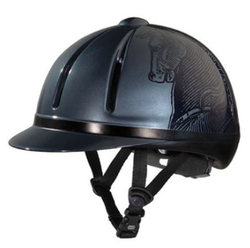Riding Helmets Are a Must, Not an Option

Buy ONLY helmets that are ASTM-SEI certified. That is the only way to ensure that the helmet is designed to protect human skulls from impact injuries. The ASTM (American Society for Testing and Materials) is an organization comprised of thousands of skilled volunteers including doctors, engineers and physicists. It is the job of the ASTM to set standards for many types of safety equipment. The ASTM has created criteria for horseback riding helmets to adhere to. These standards are summarized in ASTM F 1163. The SEI (Safety Equipment Institute) is an independent laboratory that tests helmets to be sure they meet the ASTM standard.
For mor info, see animalscience.uconn.edu/equine/helmet-safety.php
Make sure your helmet fits your head. A loose helmet endangers your life, while a too-tight helmet will give you headaches and bruises. Here's how to choose one that fits:
We recommend Troxel helmets.
For mor info, see animalscience.uconn.edu/equine/helmet-safety.php
Make sure your helmet fits your head. A loose helmet endangers your life, while a too-tight helmet will give you headaches and bruises. Here's how to choose one that fits:
- Measure the circumference of your head by wrapping a measuring tape around it. The tape should be about an inch above your eyebrows. Choose a helmet that matches that figure.
- The helmet should fit snugly on your head. That means it should slide around when you touch it or shake your head.
- The helmet should cover your entire head, including the lower back portion of your head. There should be a little room between the top of your head and the roof of the helmet.
- Adjust your helmet's chin strap so that it fits snugly under your chin. If it's too tight, you will feel like you're being strangled. If it's too loose, your helmet will not stay on your head if you sustain a fall. It will slide off, and your head will not be protected.
- The brim should be about an inch and a half above your eyebrows.
We recommend Troxel helmets.